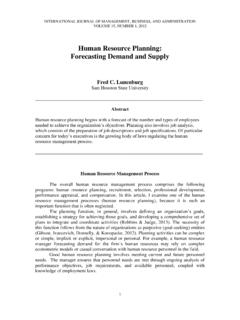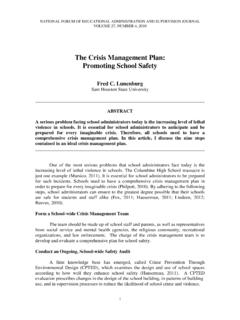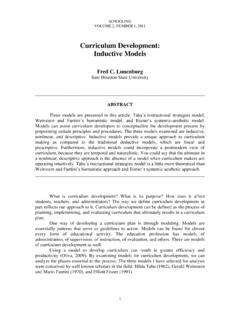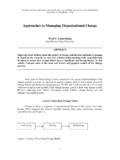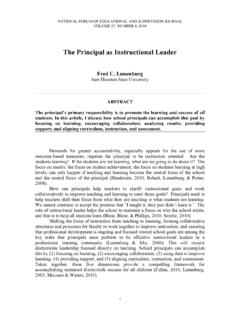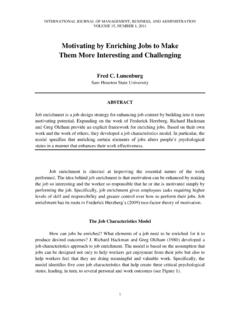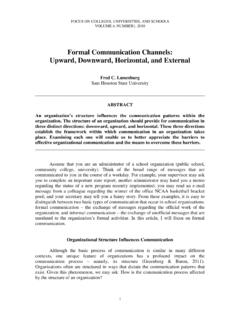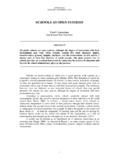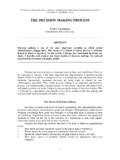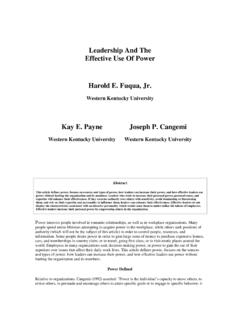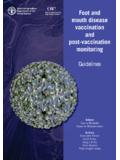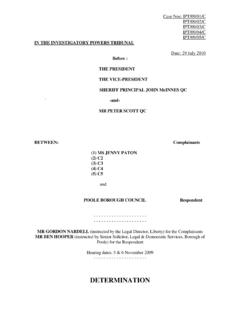Transcription of Missions in Papua New Guinea: A History of Missions …
1 NATIONAL FORUM OF MULTICULTURAL ISSUES JOURNAL VOLUME 9, NUMBER 1, 2012 1 Missions in Papua New guinea : A History of Missions among the Kafe People Robin Lumadue, MA Adjunct Professor Department of Educational Leadership College of Education and Human Services Texas A&M University-Commerce Commerce, TX Rick Lumadue, PhD Assistant Professor Department of Educational Leadership College of Education and Human Services Texas A&M University-Commerce Commerce, TX _____ Abstract The focus of this study was on the History of Missions among the Kafe people living in the Eastern Highlands Province of Papua New guinea . The study sought to determine what affect Missions had on the Kafe people. The study indicated that the Kafe people have mixed the message of Missions with their cultural worldview.
2 _____ The country of Papua New guinea (PNG) is located in the South Pacific on the eastern half of the island of New guinea , just north Australia. PNG is also comprised of many islands, including West New Britain, New Ireland, and many other smaller islands. According to the Central Intelligence Agency (2012) World Factbook, The indigenous population of Papua New guinea is one of the most heterogeneous in the world, with several thousand separate communities, and most of them with only a few hundred people; divided by language, customs, and tradition, some of these communities have engaged in low-scale tribal conflict with their neighbors for millennia. ( Papua New guinea : People and Society-People, para.)
3 28) NATIONAL FORUM OF MULTICULTURAL ISSUES JOURNAL 2_____ This small island nation has a population of nearly six million people and over 800 indigenous languages that accounts for one-tenth of the world s total languages. Even though, English, Tok Pisin (Melanesian Pidgin English) and Hiri Motu are the official languages of the country, Tok Pisin continues to be used the most, especially as a bridge language to the other hundreds of languages that are spread throughout the rugged mountainous terrain (CIA, 2012). Several countries have claimed Papua New guinea throughout its History . The countries include the Dutch, Great Britain, Germany and Australia to name a few. Neil and Own (1991) found The innumerable islands of the Pacific had to a large extent fallen prey to ruthless exploitation by traders, and their peoples seemed to be on the way to extermination.
4 Western governments stepped in, France, Britain, and Germany taking the lead, and disorder was followed by orderly government. The greater part of New guinea was unexplored, but this vast island also was neatly divided up into its Australian, Dutch, and German sections. (pp. 211-212) As a result of these other countries laying claim to PNG, Papua New guinea has been referred to by several different names since its discovery. Nelson (2000) documented these names: The names for the east of the island of New guinea are confusing. From 1884, the northeast was German New guinea and the southeast was British New guinea . In 1906, the southeast became the Australian Territory of Papua . The Australians occupied German New guinea in 1914 and in 1921, it became Australian New guinea , a territory held under mandate from the League of Nations.
5 During World War II, both Australian territories of Papua and New guinea were combined and known as New guinea . In 1945, the two territories continued under one administration as Papua -New guinea , from 1949 as Papua and New guinea , and from 1971 as Papua New guinea . The name Papua New guinea was adopted by the new nation at independence. Papua New guinea is sometimes used here for all of east New guinea before that became the official name in 1971. (p. 269) After World War II the Dutch had to begin their rule of the Western half of New guinea all over again. According to Ploegg (1999), Hence, when Dutch New guinea was re-conquered from the Japanese in the later phases of the Second World War, the Dutch government had to start almost from scratch (p.)
6 191). The influence of Australia on the History of PNG was probably the most profound. Denoon (2004) reported Miller s 1965 account about the effect of Australia on PNG: Papua has been an Australian territory since 1906. Australian pressure led the British government to take control in 1885, to keep out the Germans, who established themselves in northeastern New guinea . The German colony was taken over by Australian forces at the start of World War 1, the Australian presence being confirmed by the Paris peace conference through an Australian mandate. The territories were administered separately until World War II. After the war, the Australian mandate became a UN trusteeship; however, the UN agreed to a unified administrative system in 1949.
7 (p. 344) ROBIN LUMADUE AND RICK LUMADUE _____3 Australia functioned more as a caretaker of PNG than as a taskmaster. PNG was granted independence in 1974 from Australia (CIA, 2012). The government functions with a Parliamentary style of government. There are eighteen provinces in Papua New guinea (Statoids, 2011). PNG is very open to mission agencies and missionary work. As a result, there are many religious groups working in PNG. However, most of these groups are working in the major cities using the trade language of Melanesian Pidgin English. Because the country of PNG is so rugged and has been so difficult to reach by outsiders, many unreached people groups have remained isolated to this day. Purpose of the Study The focus of this study was on the History of mission work in the South Pacific and its expansion further west into the Eastern Highlands Province (EHP) of Papua New guinea .
8 The purpose of this study was to determine the impact Missions had on the Kafe people. The study explored areas of the culture of the Kafe people that were impacted by Missions . Missions in the South Pacific The Pacific islands (Oceania) are made up of about 1,500 islands. These islands are divided into three major groups: Polynesia, Micronesia, and Melanesia. Polynesia is the largest of the three groups and goes from Hawaii in the North to New Zealand in the South. Micronesia has the smallest group of islands, which includes the Marianas, the Caroline, Marshall, and the Gilbert Islands but is located between Hawaii and the Philippines. The Melanesian group is the third group of islands and is located south of Micronesia and north of Australia.
9 Fiji, Santa Cruz, New guinea , the New Hebrides, New Caledonia, and the Solomon Islands make up the area referred to as the Melanesia (Tucker, 1983). Roman Catholic monks were the first missionaries to come into the Pacific islands but were soon followed by Protestants who had been commissioned by missionary societies. In 1521, Magellan and his group of explorers took the first European missionary trip to the South Pacific. Four out of five of the ships landed in Marianas but then sailed to the Philippines. There were about three thousand island people that were received into the Catholic Church. Even though there was no proof as to their true understanding of Christianity, the Roman Catholic South Seas mission saw this as a high point in their missionary endeavors to the South Pacific (Tucker, 1983).
10 The discoveries of Captain Cook began to stir the imaginations of the church leaders, thus awakening Protestantism to the potential possibility of serving and evangelizing the Pacific islands. As a result of this awakening, in 1795 the London Missionary Society was formed by an interdenominational group with the purpose of reaching Tahiti. The first Protestant missionaries to the Pacific islands were British, followed by Protestants from Germany, Australia, and America (Tucker, 1983). There were a lot of hardships for these first missionaries. They had to travel for months by ship to get to one of the islands only to be left there for months or years until the next merchant ship would arrive. Tucker (1983) stated, The geographical uniqueness of the Pacific islands had from the very beginning obvious implications on mission strategy.
